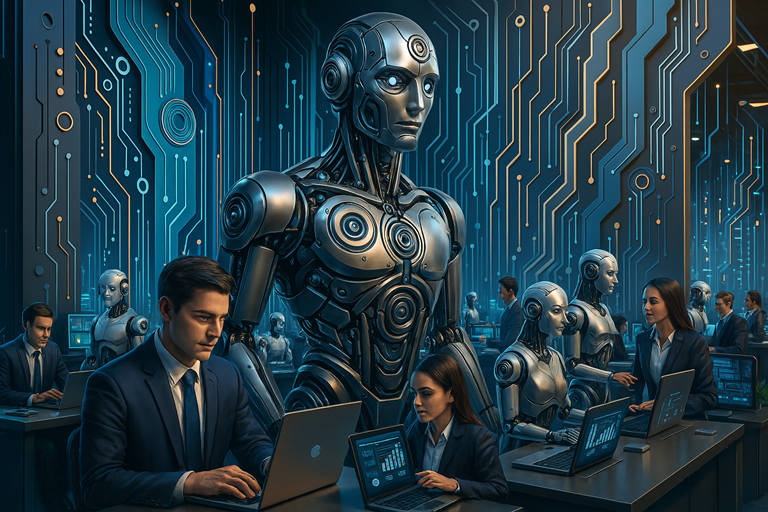
Status: Final Blueprint
Author: Shahab Al Yamin Chawdhury
Organization: Principal Architect & Consultant Group
Research Date: February 12, 2023
Location: Dhaka, Bangladesh
Version: 1.0
Executive Summary
The modern business landscape demands that the IT organization transform from a back-office support function into a strategic engine for growth and innovation. Traditional operating models, designed for stability, are no longer viable in an era of constant technological and market disruption. This blueprint provides a framework for redesigning the IT organization to be adaptable, intelligent, and value-driven. The core of this transformation is a synthesized operating model that merges the flexibility of an Adaptable Organization with the execution power of an AI-First Enterprise, structured around the flow of value to the customer and supported by dynamic funding and a future-ready workforce.
Part I: The Strategic Mandate
The imperative for a new IT design is driven by several key factors:
- The CIO’s Paradox: A permanent state where CIOs must simultaneously manage aggressive cost optimization while accelerating high-impact, AI-driven innovation. The future IT organization must be architected to manage this tension.
- Technology-Driven Disruption: The rapid evolution of technologies like agentic AI, the enterprise-wide shift to Everything-as-a-Service (XaaS), and the necessity of a data-centric operating model are reshaping business capabilities.
- New Strategic Imperatives: Beyond technology, IT must address resilience against geopolitical and cyber threats, drive sustainability (ESG) initiatives, and embed responsible, ethical innovation into its core practices.
Part II: The Architectural Blueprint
To meet these strategic demands, a new architectural foundation is required, built on two core concepts:
- The Synthesized Operating Model: This model combines the structural flexibility and empowered team networks of the Adaptable Organization with the intelligent automation and process redesign of the AI-First Organization. This creates a structure that is agile in response to external change and exponentially efficient in its internal execution.
- Product & Platform Convergence: The organization is structured into two distinct parts:
- The Product Edge: Dynamic, customer-facing teams organized around products or value streams to deliver value at high velocity.
- The Platform Core: A stable foundation of self-service tools, APIs, and services (e.g., cloud infrastructure, data platforms) that enables the Product Edge to innovate rapidly and reduces their cognitive load.
Part III: The Structural Design
The architectural blueprint is realized through a modern structural design that optimizes for the flow of value.
- Team Topologies: This framework provides a practical model for organizing teams to minimize dependencies and cognitive load. It defines four core team types:
- Stream-aligned: The primary value-delivery teams, aligned to a business domain or customer journey.
- Platform: Provides internal, self-service platforms and tools to accelerate the work of stream-aligned teams.
- Enabling: Helps stream-aligned teams acquire missing capabilities (e.g., security, test automation).
- Complicated Subsystem: Manages a part of the system requiring deep, specialized knowledge.
- Agile Governance & Dynamic Funding: The traditional annual, project-based funding model is a key blocker to agility. The future model requires a shift to:
- Value Stream Funding: Allocating budgets to persistent, product-aligned teams rather than temporary projects. This provides financial stability while allowing for strategic flexibility.
- Scaled Agile Frameworks: Using frameworks like SAFe or LeSS to coordinate work across multiple teams while ensuring alignment with enterprise strategy and governance controls like COBIT 2019.
Part IV: The Human Element
Technology and structure are only effective when supported by the right talent and culture.
- Critical Future Roles: The new model creates demand for new, multidisciplinary roles:
- IT Product Manager: The strategic “CEO” of a product, responsible for its vision, roadmap, and delivering business outcomes.
- Site Reliability Engineer (SRE): Treats operations as a software engineering problem, focusing on automating “toil” and ensuring the reliability and scalability of production systems.
- AI Ethicist: Guides the responsible development and deployment of AI systems, ensuring fairness, transparency, and alignment with societal values.
- Adaptive, AI-Fluent Culture: The transformation requires a culture that embraces:
- AI Fluency: AI literacy is becoming a baseline competency. Organizations must democratize access to AI tools and integrate them into daily workflows.
- Psychological Safety & Growth Mindset: A culture where teams feel safe to experiment and “fail fast,” and where continuous learning is embedded into daily work.
Part V: The Implementation Roadmap
A phased, 24-month transformation journey mitigates risk and builds momentum.
- Phase 1: Assess & Design (Q1-2):
- Secure executive sponsorship and establish design principles.
- Conduct a digital maturity assessment to create a baseline.
- Design the target operating model and create a detailed implementation plan.
- Phase 2: Pilot & Iterate (Q3-4):
- Select a single, high-impact value stream for a pilot program.
- Form and train the pilot teams in the new ways of working.
- Launch the pilot, gather feedback, and refine the model.
- Phase 3: Scale & Optimize (Q5-8):
- Roll out the new model across the IT organization in waves.
- Formalize new roles, career paths, and the dynamic funding model.
- Continuously measure performance and drive ongoing improvement.
Part VI: Measuring Success
A Balanced Scorecard provides a holistic framework for tracking the transformation’s progress and demonstrating value.
| Perspective | Example Key Performance Indicators (KPIs) |
| Financial | – TCO Reduction – ROI of Agile Transformation |
| Customer/Stakeholder | – Time-to-Market – Business Stakeholder Satisfaction (NPS) |
| Internal Processes | – Flow Velocity – DORA Metrics (e.g., Deployment Frequency, MTTR) |
| Learning & Growth | – Employee Engagement (eNPS) – Digital/AI Skill Index Score |